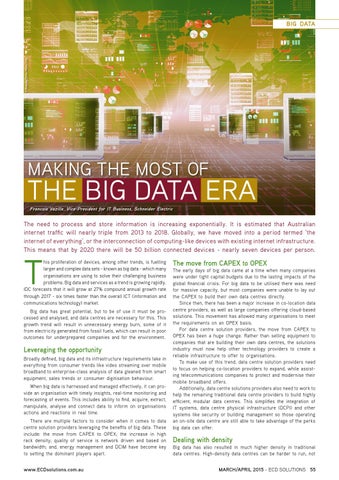Š Nmedia/Dollar Photo Club
BIG DATA
MAKING THE MOST OF
THE BIG DATA ERA Francois Vazille, Vice-President for IT Business, Schneider Electric
The need to process and store information is increasing exponentially. It is estimated that Australian internet traffic will nearly triple from 2013 to 2018. Globally, we have moved into a period termed ‘the internet of everything’, or the interconnection of computing-like devices with existing internet infrastructure. This means that by 2020 there will be 50 billion connected devices - nearly seven devices per person.
T
his proliferation of devices, among other trends, is fuelling larger and complex data sets - known as big data - which many organisations are using to solve their challenging business problems. Big data and services as a trend is growing rapidly. IDC forecasts that it will grow at 27% compound annual growth rate through 2017 - six times faster than the overall ICT (information and communications technology) market. Big data has great potential, but to be of use it must be processed and analysed, and data centres are necessary for this. This growth trend will result in unnecessary energy burn, some of it from electricity generated from fossil fuels, which can result in poor outcomes for underprepared companies and for the environment.
Leveraging the opportunity Broadly defined, big data and its infrastructure requirements take in everything from consumer trends like video streaming over mobile broadband to enterprise-class analysis of data gleaned from smart equipment, sales trends or consumer digitisation behaviour. When big data is harnessed and managed effectively, it can provide an organisation with timely insights, real-time monitoring and forecasting of events. This includes ability to find, acquire, extract, manipulate, analyse and connect data to inform on organisations actions and reactions in real time. There are multiple factors to consider when it comes to data centre solution providers leveraging the benefits of big data. These include: the move from CAPEX to OPEX; the increase in high rack density; quality of service is network driven and based on bandwidth; and, energy management and DCIM have become key to setting the dominant players apart.
www.ECDsolutions.com.au
The move from CAPEX to OPEX The early days of big data came at a time when many companies were under tight capital budgets due to the lasting impacts of the global financial crisis. For big data to be utilised there was need for massive capacity, but most companies were unable to lay out the CAPEX to build their own data centres directly. Since then, there has been a major increase in co-location data centre providers, as well as large companies offering cloud-based solutions. This movement has allowed many organisations to meet the requirements on an OPEX basis. For data centre solution providers, the move from CAPEX to OPEX has been a huge change. Rather than selling equipment to companies that are building their own data centres, the solutions industry must now help other technology providers to create a reliable infrastructure to offer to organisations. To make use of this trend, data centre solution providers need to focus on helping co-location providers to expand, while assisting telecommunications companies to protect and modernise their mobile broadband offers. Additionally, data centre solutions providers also need to work to help the remaining traditional data centre providers to build highly efficient, modular data centres. This simplifies the integration of IT systems, data centre physical infrastructure (DCPI) and other systems like security or building management so those operating an on-site data centre are still able to take advantage of the perks big data can offer.
Dealing with density Big data has also resulted in much higher density in traditional data centres. High-density data centres can be harder to run, not
MARCH/APRIL 2015 - ECD SOLUTIONS 55
